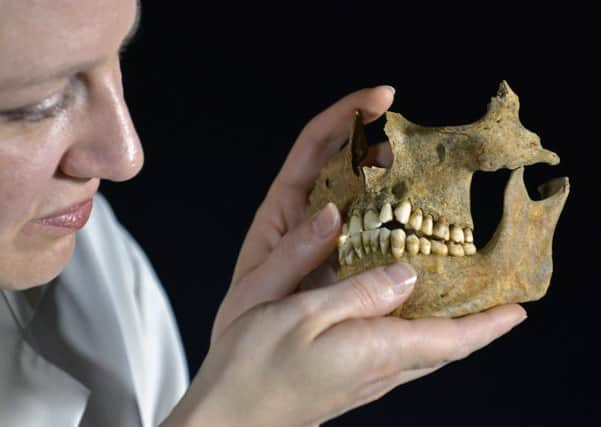Campaign to return soldiers’ skeletons launched


The remains of 28 Scots soldiers were discovered in a mass grave in the grounds of Durham Cathedral in November 2013.
Analysis of the bones earlier this year revealed that the group were likely to be among the 10,000 Scottish soldiers captured by Cromwell’s forces at the Battle of Dunbar in 1650.
Advertisement
Hide AdAdvertisement
Hide AdThe soldiers - between 13- and 25-years-old - likely died of disease, cold or malnutrition whilst waiting to be sold into slavery by English troops after the long forced march south.
Now a petition is calling for the remains of the “Dunbar Martyrs” to be brought home and reburied in Scotland. Although 28 sets of remains have been recovered it is thought there could be many more.
The campaign is led by amateur historian George Wilson, from Dunbar, East Lothian, whose petition has so far raised more than 450 signatures - fast approaching its target of 500.
The prisoners of war were herded into the grounds of Durham Cathedral but so neglected that as many as 1,700 died. The skeletons were discovered during the construction of a new cafe.
Wilson - a human resources manager by day - said: “I launched the petition to gauge opinion on repatriation of the remains and reburial at an appropriate site in Scotland.
“The petition, now with several hundred supporters, contains comments that appear overwhelming in their view that as the Scots were captured whilst defending Scotland from an invading army, and whether Royalist, Covenanter or not, they should be brought home to Scotland for reburial.
“Those who perished were Jock Tamson’s bairns.”
He added: “It is with near genealogical certainty that some reading this within present day Scotland will be directly related to those that perished at Durham.”
His petition to have the fallen soldiers repatriated has gained enormous momentum, with messages of support from Scotland and across the world.
Advertisement
Hide AdAdvertisement
Hide AdAlthough there is currently no firm plan for where in Scotland the remains should be reburied, Jeanette Anderson, from Leven in Fife, and a signatory of the petition, said: “I believe they should be brought home and buried in their home towns to recognised for their part in the war.”
Another supporter, Kath Ramsay from Hawick, added: “Bring Them home.”
And Eamonn Toland, living in Doha in Qatar said: “I think it is only right this should be honoured.”
Professor David Cowling, pro-vice-chancellor at Durham University agreed that bringing the soldiers home may be on the table.
He said both the university and cathedral were “committed to working with interested parties and organisations to determine what will happen to the remains of the Scottish soldiers and we are already engaging with them.
“The soldiers will eventually need to be reburied according to the terms of the exhumation licence issued by the Ministry of Justice.
“As currently formulated this licence requires reinterment in the nearest active burial ground.
“If considered appropriate we may seek to vary the terms of the licence for reburial elsewhere and to allow time for important further research which would cast more light on the lives and deaths of these individuals.”
Advertisement
Hide AdAdvertisement
Hide AdThe Battle of Dunbar was fought between Cromwell’s Parliamentarian army and Scottish Royalists.
Cromwell invaded Scotland in July 1650, and after two months the Scottish general Sir David Leslie confronted him with an army of 12,000 at Dunbar.
Cromwell outmaneuvered the Scots army with his smaller force of 11,000 - slaughtering between 800 and 3,000, and taking up to 10,000 prisoner.
The prisoners were marched south to be shipped to the Caribbean to work as indentured slaves, but around 1,700 died whilst imprisoned at Durham Castle and Cathedral.
